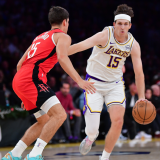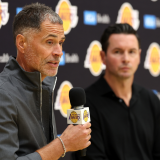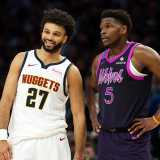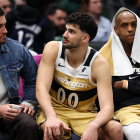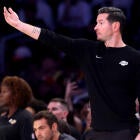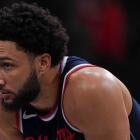
NBA Offseason Reports: Miami Heat
A 2012 NBA offseason report for the Miami Heat.
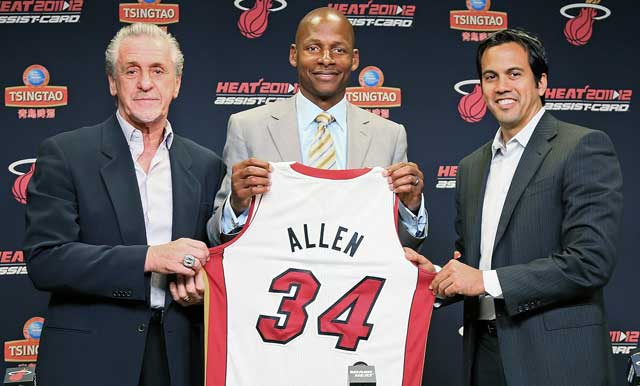 |
| Ray Allen was the highlight of the Miami Heat's offseason. (Getty Images) |
Over the next month, CBSSports.com's Eye On Basketball will take a team-by-team look at the 2012 NBA offseason. First up: the Miami Heat, the 2012 NBA Champions.
Check out Eye On Basketball's podcast with host Matt Moore and guest Ethan J. Skolnick, Heat beat writer for the Palm Beach Post, for more on Miami's summer.
I. How They Finished 2011-12
On top of the world, of course. The Heat won their second title in franchise history and MVP forward LeBron James got the "can't perform in the fourth quarter" and "never won a ring" monkeys off of his back. It was finally -- after all these years and a loss in the 2011 Finals -- totally good to be the King.
After dispatching the New York Knicks (5 games) and Indiana Pacers (6 games), the Heat gutted out a memorable Eastern Conference finals with the Boston Celtics in seven games, riding the return of All-Star forward Chris Bosh to play a sensational fourth quarter during the series finale. It took Miami just five games to finish off the Oklahoma City Thunder, bouncing back from a Game 1 loss to steal Game 2 on the road and then slam the door in three straight games at the American Airlines Arena. James was named Finals MVP after averaging 30.3 points, 9.7 rebounds, 5.6 assists and 1.9 steals in 42.7 minutes per game during the 2012 playoffs. This was the world's best player reaching new heights in his certain Hall of Fame career, bringing everyone along for the ride.
II. Needs Entering The Offseason
Miami's title was convincing but it wasn't flawlessly executed. Indeed, when Bosh first went down with a strained abdominal muscle it briefly appeared like the Heat might not advance out of the Eastern Conference semifinals. James eventually covered up Miami's flaws just enough, playing more in the post to make up for a lack of quality on the frontline and doing more himself offensively to offset sometimes inconsistent play from the Heat's perimeter players. Miami was forced to juggle rotations and lineups due to the various injuries, and even All-Star guard Dwyane Wade was bothered by a knee issue, which needed to be drained during the playoffs and later required minor offseason surgery.
The biggest needs entering the offseason, then, were added rotation depth and, if possible, a talent upgrade in the middle. Given the massive salaries going to the Big 3 -- the Heat will pay more than $52 million to James, Wade and Bosh in 2012-13, when the salary cap is set at $58 million -- landing a big-time talent at the center position was never a truly realistic option.
III. The Draft
Miami's recent strategic approach hasn't been very Draft-centric. While the franchise centerpiece, Wade, was selected in the 2003 Draft and guard Mario Chalmers was acquired in a 2008 Draft day trade, James, Bosh, Shane Battier, Mike Miller, James Jones, Joel Anthony, Juwan Howard and Ronny Turiaf all arrived via free agency or free agency-driven trades. 2011 first-round pick Norris Cole and 2010 second-round pick Dexter Pittman were bit players on the title run.
Often, in recent years, Miami has essentially punted out of the Draft. That strategy continued in 2012, when the Heat selected Mississippi State forward Arnett Moultie with the No. 27 pick and then traded him to the Philadelphia 76ers, for a future first-round pick and the rights to second-round pick Justin Hamilton, a center out of LSU. The move provided Miami with the flexibility that comes with not paying a guaranteed salary and committing a roster spot to a first rounder. The roster spot issue is always something to keep an eye on for the Heat, as they have cycled through players in their 14th and 15th roster spots with great regularity during the Big 3 era, as positional needs and injuries have demanded.
IV. Free Agency
This summer marked the official beginning of "welcome ring-chasers, we are your No. 1 destination" mode for the Heat. It couldn't come at a better time for Miami, who has most of its salary cap space tied up in three players and is dealing with increasingly tight and punitive rules thanks to the NBA's new collective bargaining agreement. Put simply, Miami was looking for the best possible players this summer and hoping they would accept bargain basement prices for the right to play on a team that enters the 2012-13 season as the clear favorites to repeat their 2012 title.
This isn't a completely new strategy for Miami, who netted Battier in December 2011 and previously signed Miller and Howard with the same pitch. This summer, though, the Heat saw extraordinary returns.
The big coup was future Hall of Fame guard Ray Allen, a knockdown sharp-shooter plucked from the Boston Celtics, Miami's major conference rival. Allen arrives on a 3-year mini mid-level contract worth $3 million per year, a salary that reflects a deep discount on his market value. Allen, 37, is years removed from his prime and underwent ankle surgery this offseason, but the demands on his body will be far less in Miami, where James and company will carry the bulk of the load. Allen will simply be asked to space the floor and knock down open shots, another weapon who could be worked into super-versatile, super-lethal, perimeter-oriented line-ups by coach Erik Spoelstra. With the futures of Miller and Jones uncertain because of injuries and age, Allen plugs in as upgrade over both, capable of providing reliable production and injury protection when Wade deals with the inevitable bumps and bruises. He brings championship experience and a total commitment to the game, too. It doesn't get much better than that at this price.
Miami's other move was also nice, nabbing veteran forward Rashard Lewis off of the buyout pile. Best known in recent years as one of the NBA's most overpaid players, Lewis was traded by the Washington Wizards to the New Orleans Hornets this summer, who swallowed the necessary portion of his remaining salary, making him a free agent. With more than $138 million in career earnings to his name and another big pay day already set for 2012-13, Lewis was a perfect candidate to join the Heat for peanuts. He gets his first chance to make a deep playoff run since he went to the 2009 NBA Finals with the Orlando Magic; the Heat get a talented forward who still has some game left at 32, one who can stretch the floor, score the ball and is a good locker room guy as well. While not particularly burly, Lewis would have been helpful last season during Bosh's injury absence. He represents that same type of protection going forward. That he does all of those things at just over $1 million for the 2012-13 season is the icing on the cake.
V. Overall Grade
Adding Allen and Lewis made the NBA's best team better. The only rotation defection, to this point, was big man Ronny Turiaf, who signed with the Los Angeles Clippers. An energy and hustle player, Turiaf isn't exactly leaving a major hole on a team that prefers to play small-ball and still has the likes of Anthony and Haslem to handle rebounding duties. That Miami got better and that they did so in such an affordable manner should send shivers down the spines of the competition. The Heat were devastasting on the court this season and their summer has simply been a continuation. In the months since hosting the Larry O'Brien trophy, Miami showed a clear understanding of its strengths (premier players in their prime, wide open championship window, desireable market) and weaknesses (lack of depth, mediocre bench talent), and then used the former to address the latter in a coolly efficient manner.
Miami entered the summer as odds-on favorites to repeat their 2012 title in 2013 and they will exit the summer having fortified that position. Grade: A

